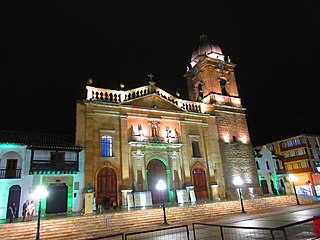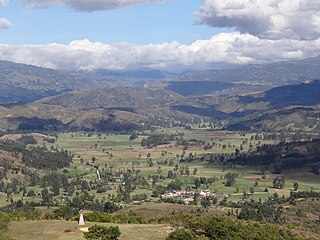
Arecibo is a city and municipality on the northern coast of Puerto Rico, on the shores of the Atlantic Ocean, located north of Utuado and Ciales; east of Hatillo; and west of Barceloneta and Florida. It is about 50 miles (80 km) west of San Juan, the capital city. Arecibo is the largest municipality in Puerto Rico by area, and it is the core city of the Arecibo Metropolitan Statistical Area and part of the greater San Juan Combined Statistical Area. It is spread over 18 barrios and Arecibo Pueblo. Its population in 2020 was 87,754.
Campesino means 'farmer' or 'peasant' in Spanish.

A cacique was a tribal chieftain of the Taíno people, the indigenous inhabitants at European contact of the Bahamas, the Greater Antilles, and the northern Lesser Antilles. The term is a Spanish transliteration of the Taíno word kasike.
Trujillo or Truxillo may refer to:
Agüeybaná was the principal and most powerful cacique (chief) of the Taíno people in "Borikén" when the Spanish first arrived on the island on November 19, 1493.

Tunja is a city on the Eastern Ranges of the Colombian Andes, in the region known as the Altiplano Cundiboyacense, 130 km northeast of Bogotá. In 2018 it had a population of 172,548 inhabitants. It is the capital of Boyacá department and the Central Boyacá Province. Tunja is an important educational centre of well-known universities. In the time before the Spanish conquest of the Muisca, there was an indigenous settlement, called Hunza, seat of the hoa Eucaneme, conquered by the Spanish conquistadors on August 20, 1537. The Spanish city was founded by captain Gonzalo Suárez Rendón on August 6, 1539, exactly one year after the capital Santafé de Bogotá. The city hosts the most remaining Muisca architecture: Hunzahúa Well, Goranchacha Temple and Cojines del Zaque.

Edwin Carlos Colón is a Puerto Rican professional wrestler best known for his time with WWE, where he performed under the ring name Primo Colón, or simply Primo. He now competes in the World Wrestling Council (WWC) under his real name, Eddie Colón.

William Anthony Colón Román is an American salsa musician and social activist. He began his career as a trombonist and also sings, writes, produces and acts. He is also involved in the politics of New York City. Colón is considered a pioneer of Salsa music and a best-selling artist in the genre, having been a key figure in the nascent New York City scene associated with the legendary Fania Records. He is also noteworthy for having assumed the gangster image in his album covers before it was culturally popular.

Cacique is a Venezuelan brand of rum first marketed in 1959. It is the best-selling rum in Venezuela and a leading exporter to other South American countries and Europe. The Cacique product lines are owned by Diageo, the largest multinational beer, wine and spirits company in the world. The word "cacique" means "chief of the tribe" in Spanish.

Carlos Edwin Colón Jr. is a Puerto Rican professional wrestler. He is best known for his time with WWE, under the ring name Carlito. He is currently making appearances for multiple promotions, including Qatar Pro Wrestling where he is the current QPW Tag Team Champions with Chris Masters.
Cristobal Colon may refer to:
The Caribbean Bloc of the FARC-EP was a medium-sized FARC-EP bloc which operated in the northern areas of Colombia and along the Caribbean coast, with routes and access to the coast being strategically important, and was thus sometimes referred to as the Northern Bloc. At the end of the 1990s the group had much control over the rural areas connecting the urban centers of the Caribbean region, but in the 2000s was forced to retreat into the more inhospitable Andes. The group's leaders have been held responsible for numerous kidnappings and killings along the entire Caribbean coast, including the urban centers Cartagena, Barranquilla, Valledupar and Santa Marta. This bloc was also the center of the high-profile kidnapping of Fernando Araújo, who recovered his freedom during a Colombian National Army offensive in early 2007.

Úmbita is a town and municipality in the Márquez Province, part of the Colombian department of Boyacá. Úmbita is situated on the Altiplano Cundiboyacense at a distance of 70 kilometres (43 mi) from department capital Tunja and borders Nuevo Colón and Tibaná in the north, Chinavita in the east, La Capilla and Tibiritá (Cundinamarca) in the south and in the west Villapinzón (Cundinamarca) and Turmequé. The altitude within the municipality ranges from 1,600 metres (5,200 ft) to 3,400 metres (11,200 ft).

Bohechío is a town in the San Juan province of the Dominican Republic. It is located northeast of the km 25 of Azua – San Juan road at a distance of 26.5 km and 43 km from San Juan Province, 205 km from Santo Domingo and 92 km of the Province Azua, nestled between mountains at the foot of the Cordillera Central. It has a land area of 428.33 km2.

Caciques de Humacao was a professional basketball team based in Humacao, Puerto Rico. The club competed in the National Superior Basketball.
The Spanish and Taíno War of San Juan–Borikén, also known as the Taíno Rebellion of 1511, was the first major conflict to take place in modern-day Puerto Rico after the arrival of the Spaniards on November 19, 1493.
Areíto or areyto was a Taíno language word adopted by the Spanish colonizers to describe a type of religious song and dance performed by the Taíno people of the Caribbean. The areíto was a ceremonial act that was believed to narrate and honor the heroic deeds of Taíno ancestors, chiefs, gods, and cemis. Areítos involved lyrics and choreography and were often accompanied by varied instrumentation. They were performed in the central plazas of the villages and were attended by the local community members as well as members of neighboring communities.

The iraca, sometimes spelled iraka, was the ruler and high priest of Sugamuxi in the confederation of the Muisca who inhabited the Altiplano Cundiboyacense; the central highlands of the Colombian Andes. Iraca can also refer to the Iraka Valley over which they ruled. Important scholars who wrote about the iraca were Lucas Fernández de Piedrahita, Alexander von Humboldt and Ezequiel Uricoechea.
Cacique democracy is a term that has been used to describe what has been observed as the feudal political system of the Philippines, where in many parts of the country local leaders remain very strong, with warlord-like powers. The term was originally coined by Irish-American political scientist Benedict Anderson.

Pablo Miguel Ansaloni is an Argentine trade unionist and politician who was a National Deputy from 2017 to 2012, elected in Buenos Aires Province. He was a member of UATRE, the rural workers' union, until his expulsion in 2021. He is a member of the minor Faith Party.











